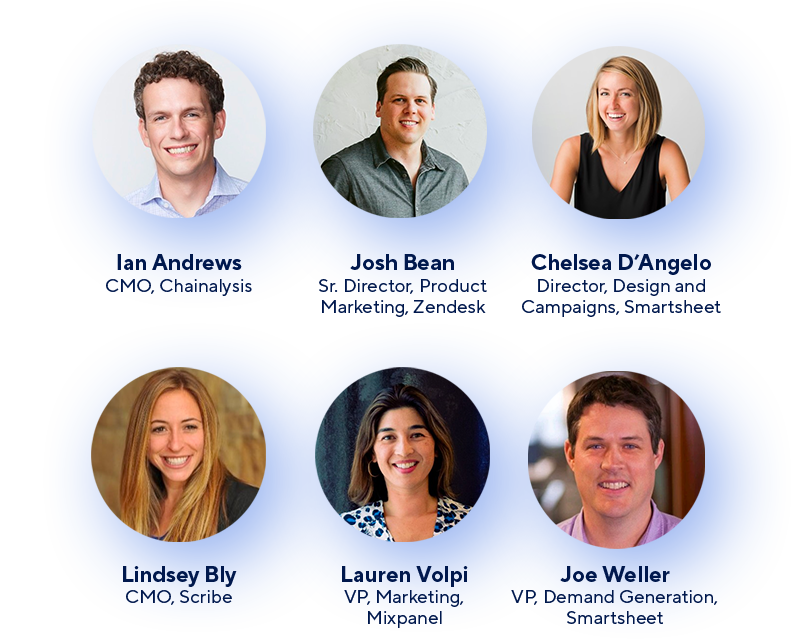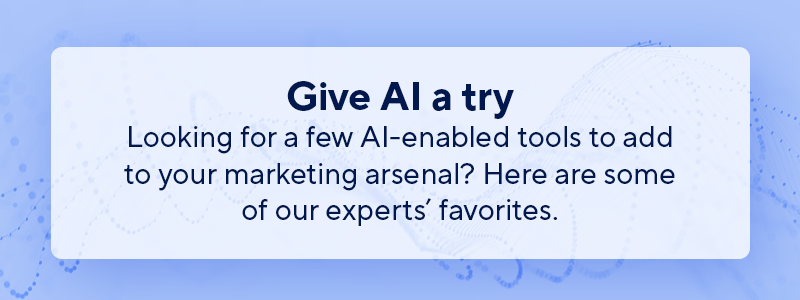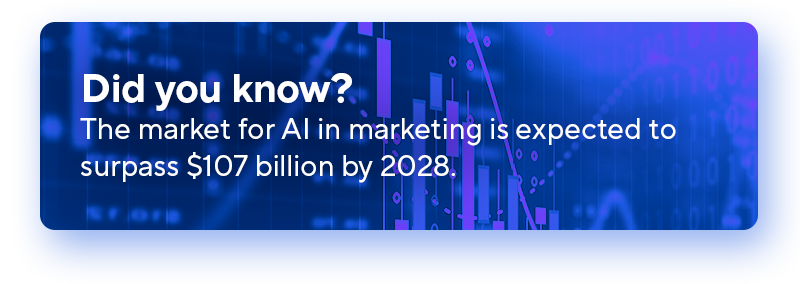Article
Harnessing AI to achieve more with less: Marketing leaders sound off
July 13, 2023
Your marketing team is under intense pressure to hit growing goals with shrinking budgets and resources. As one of their fearless leaders, you must find creative, cutting-edge ways to help them succeed — and arguably, no solution has ever been more exciting or debated than artificial intelligence (AI).
For years we’ve been wondering how “robots” could possibly affect our work lives, but with the recent launch of AI-driven platforms like OpenAI’s ChatGPT, the day is finally here. In fact, more than 60% of marketers say they have already started using AI in their marketing efforts.
From eliminating manual workflow steps to learning teams’ content search behaviors and surfacing relevant assets, technology’s ability to help teams achieve more with less is endless — but marketers are just beginning to understand AI’s potential. And for the 37% who have yet to harness AI, the No. 1 reason is “lack of understanding or knowledge.”
That’s why we prompted six of today’s best and brightest marketing minds to tell us how they’re currently using AI to maximize their teams’ resources and deliver maximum impact. We also asked them to share how they envision AI usage will evolve to empower and uplift marketers in the future. Let’s see what they have to say!
Meet our experts
How are marketing teams currently harnessing AI to maximize their resources and deliver the most impact?
"We’ve found that generative AI works best as an ‘assistant’ to our team.
Rather than trying to offload final tasks entirely to AI, we’ve found the most success in using it as a complement to our team so we can move faster and even increase our creativity.
Our content team, in particular, has been using generative AI on a near-daily basis in two key areas: developing outlines for longer-form content, which we then pass off to a writer, and repurposing original content, for example, by turning a podcast interview into blog posts, social posts, etc.
“The rest of our team uses AI on a more ad hoc basis — ChatGPT, in particular, can be really helpful if you’re in a creative rut or are facing writer’s block. It requires a bit of prompt engineering, but you can really get a good brainstorm going and crank out some new takes on everything from email subject lines to webinar titles. We’ve even riffed with ChatGPT to develop our understanding of our personas. A bit more unexpected, ChatGPT is incredible at writing Google Sheets formulas. It’s a huge time savings for anyone living in spreadsheets, and it’s also empowering for Google Sheets newbies.
“We just released our own AI product at Scribe. We’re growing rapidly as a team, and while documentation is important, it’s safe to say no one loves doing it. We use Scribe AI to auto-document new processes as we build them to pass off to both our team and customers.”
- Lindsey Bly, CMO, Scribe
“AI has emerged as an essential tool for businesses looking to maximize their resources and deliver substantial impact, particularly in areas such as data analysis, personalization, summarization, and content generation for demonstrations. AI and machine learning tools can process vast volumes of data swiftly and efficiently. These sophisticated tools are also adept at formulating queries for specific data pulls, making the data analysis process even more streamlined and effective.
“We’ve run several tests with AI in personalizing content and the results have been very promising. AI was able to transform generic content into targeted messaging that catered to a multitude of industries and use cases. The ability to customize content in such a manner enhances its appeal, leading to better engagement and conversion rates. We've also begun using AI to create hyper-personalized content for demo accounts. This AI-generated content is tailored to closely match the profile of the potential customer, providing them with a highly relevant and familiar experience during the demonstration phase.”
- Josh Bean, Sr. Director, Product Marketing, Zendesk
“We have experiments running across a few areas to test the ability of AI tools. We’re hoping to give the large language model (LLM) access to past request for proposal (RFP) responses, company and product content, and documentation, and then use the LLM to produce responses to new RFPs. If successful, this will save hours to days of human time per month and likely increase the quality and consistency of our proposal content.
“I have a data science team in my org that produces a lot of research about what’s happening on the blockchain — things like crime trends or adoption statistics — and we often get requests for custom cuts of the data. We’re evaluating if we can make this self-service for our internal teams with an LLM interface to request the data that acts as a front end to our proprietary data. This would allow for scaling up our custom research products without adding more data scientists and would make us more responsive to our business partners.
“We also create a lot of custom header images for our blogs, podcasts, and research. We’re testing the tools like Midjourney and DALL-E to determine if we can get them to produce an on-brand original image that is better than the stock photos we usually customize for these purposes. Again, the ideal outcome would be better quality, faster production processes, and fewer staff needed as we continue to grow.”
- Ian Andrews, CMO, Chainalysis
“The teams I’ve led have already been leaning on AI for simple yet meaningful support that helps them do their jobs faster and better. Take for instance adding captions to videos or getting interviews transcribed so that you can jump into the real work versus getting bogged down with the pre-work you need to even get to the starting line. It accelerates human work and takes the headache out of it.
“Consider all of the supporting assets that are needed to distribute any piece of content: social, email, landing pages, teasers, ads, etc. Once the brilliant thoughts have all been pulled together in one piece, the work isn’t done. But could AI facilitate faster first drafts of these short-form assets that writers could then more quickly edit into the final social piece, all in a fraction of the time? That’s where we’re headed.
“And while many say that making things more efficient means less people are needed, I’d disagree, at least specific to the creative field. The demands of the digital landscape today only keep increasing — more content, more design, more video — and all of it needs to be higher quality while still being thoughtful and smart. We need some efficiency gains if we’re going to be able to keep up.”
- Chelsea D’Angelo, Director, Design and Campaigns, Brandfolder
“Right now, our digital marketing team leverages AI to help support their SEO efforts in building out related topics and key terms around marketing and product analytics. Before AI, the process to build out keyword lists was very manual and contained in Excel lists that had to be reviewed and curated by multiple stakeholders. In addition to the list building, there is a lot of research that has to be done on paid sites like Moz and Google Trends.
“But with AI and tools like ChatGPT, so many steps are saved, as the trends and lists can be pre-populated, saving hours of time. Our outbound team is also experimenting with AI to build out their personalized outreach sequences based on the person they are targeting and what outcome they are trying to achieve, albeit a meeting, reconsideration, or just a response.”
- Lauren Volpi, VP, Marketing, Mixpanel
“We’re currently using AI to help guide bidding decisions on the paid ads side based on a pretty sophisticated model that we’re feeding to Google. It’s no longer enough to just keep manually bidding on keywords and generating superficial conversion events (like form fills), which is why we train the Google AI bidding model with our bottom funnel win data, and let the AI find the best audiences for us in a way that humans just can't.
“Our sales outreach team also uses AI to customize the content they send to people who sign up for a free trial. We’re able to craft libraries of email snippets and sequences ahead of time based on users’ companies, roles, and use cases, and then we let AI mix and match them to create automated, personalized outreach.
“And lastly, our optimization team can use AI to come up with landing pages and new copy ideas based on best-in-class landing pages, for example. It gives the team a really good starting point and offers some initial test ideas so they never have to start with a blank slate.”
- Joe Weller, VP, Demand Generation, Smartsheet
How will the future of AI continue to empower and uplift marketers?
“I firmly believe that people who invest time to become skilled in this generation of tools will be in high demand in much the same way as a Marketo or Salesforce admin is a must-have for any reasonable scale of marketing organization. Those people will be more efficient and deliver more and higher quality projects. And conversely, those who don’t learn how to augment their work processes will fall behind the expected productivity curve.”
- Ian Andrews, CMO, Chainalysis
“The sky’s the limit! As generative AI models improve and cover more mediums, I think the playing field will level out. It’ll be possible for marketers with fewer resources and lower budgets to run campaigns that would have previously been completely out of the realm of reality. I think we’ll also see AI tackle some big marketing operations challenges: connecting tools, cleaning and evaluating data, and deriving insights. AI has made writing formulas and code and even working in no-code tools more accessible to everyone.
“I’d love to see a future where anyone can easily set up the marketing tech stack of their dreams by working with AI. There’s of course a lot of talk around jobs, especially in marketing, being replaced by AI. I think instead what we’ll see is those who learn how to effectively partner with AI will have the advantage.”
- Lindsey Bly, CMO, Scribe
“In the immediate future I see AI continuing to absorb many of the routine, repetitive tasks that teams have to waste time on every day. Marketers will have so much more time to innovate and be strategic and focus on optimizing results. But honestly, AI is evolving and progressing so rapidly it’s tough to know exactly what the future looks like. Just over 6 months ago nobody knew what ChatGPT was, and now it’s changed our entire world.
“So I think the best way marketers can prepare is to just stay as close to it as possible. Soon everyone will be sending AI-customized emails, and consumers will become desensitized to it. So what’s the next evolution of this? You can’t just sit back and wait to find out — you have to experiment. That’s how marketers will get ahead and make sure they’re reaping the full benefits of AI in the future.”
- Joe Weller, VP Demand Generation, Smartsheet
“AI is transforming the marketing landscape, promising a shift toward more strategic roles for marketing professionals. As AI improves, it's anticipated to automate time-consuming tasks like idea generation and content creation, freeing up marketers' time. Advanced AI can analyze large data volumes to identify trends and generate marketing strategies. Also, AI's capacity for content generation is rapidly improving, producing increasingly sophisticated and targeted content, and hence reducing marketers' time spent on crafting messaging.
“This evolution will likely transition marketing managers from creators to curators or approvers, focusing more on refining AI-generated strategies and content. It opens up opportunities for high-level planning, brand storytelling, building emotional customer connections, and skill enhancement in AI and data science.
Embracing this shift as an opportunity rather than a challenge will allow marketers to leverage AI to elevate their roles and contribute more strategically to their organizations.”
- Josh Bean, Sr. Director, Product Marketing, Zendesk
“We’re at a frontier right now. And not because AI is new, because it’s not. But the advances in generative AI are recent and push us into precarious new territory. For some time now, we’ve had AI that helps us do — facilitates tasks and eliminates manual steps. But generative AI is about helping us think. And mind you, it’s not about doing the thinking for us — that’s different. But it starts us down a path, wrong or right, by pulling from outside information much in the way our brains pull from past experiences.
“I heard a quote recently that I really liked from Reid Hoffman, who’s the co-founder of LinkedIn, and he started by quoting Steve Jobs’ saying, ‘Computers are like the bicycle for our mind.’ And then he went on to equate AI with being the steam engine for the mind. It’s a compelling way to think about it. Will it change a lot? Yes. Will there be some bad with some good? Highly likely. But in the end, if we’re thoughtful about how we use it, who has access to it, and what limitations are put in place, the opportunities are almost endless.”
- Chelsea D’Angelo, Director, Design and Campaigns, Brandfolder
Enhance your team’s ability to do more with less
Whether today’s marketing leaders are using AI to personalize content, generate on-brand imagery, or serve up custom research, they’re finding increasingly innovative and impactful ways to supercharge their marketing efforts. However, leveraging AI is just one of many ways to empower your team in the face of shrinking budgets and headcount.
Our latest e-book dives into several strategies marketing leaders like you can harness to eliminate silos that are getting in the way of doing more with less.


